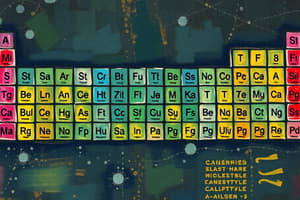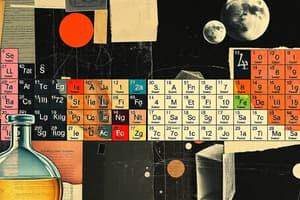Podcast
Questions and Answers
What happens to the ionisation energy down a group?
What happens to the ionisation energy down a group?
Decreases
Explain the trend in melting points of period 2 elements.
Explain the trend in melting points of period 2 elements.
Melting points peak towards the middle of the period.
Why do Lithium and Beryllium have increasing melting points?
Why do Lithium and Beryllium have increasing melting points?
Due to greater positive charged ions.
What type of bonds do Boron and Carbon form?
What type of bonds do Boron and Carbon form?
What type of molecules are Nitrogen, Oxygen, Fluorine, and Neon?
What type of molecules are Nitrogen, Oxygen, Fluorine, and Neon?
Explain the trend of first ionisation energies along period 2.
Explain the trend of first ionisation energies along period 2.
Why do Boron and Oxygen exhibit exceptions to the trend of increasing first ionization energy across Period 3?
Why do Boron and Oxygen exhibit exceptions to the trend of increasing first ionization energy across Period 3?
How does the metallic bonding in Sodium, Magnesium, and Aluminium contribute to their increasing melting points across Period 3?
How does the metallic bonding in Sodium, Magnesium, and Aluminium contribute to their increasing melting points across Period 3?
Why does Silicon have a very high melting point compared to other Period 3 elements?
Why does Silicon have a very high melting point compared to other Period 3 elements?
What type of bonding holds Phosphorus, Sulphur, and Chlorine together?
What type of bonding holds Phosphorus, Sulphur, and Chlorine together?
Explain why Argon has a very low melting point compared to the other Period 3 elements.
Explain why Argon has a very low melting point compared to the other Period 3 elements.
How do the quantum behavior of electrons in Boron and Oxygen affect their first ionization energy?
How do the quantum behavior of electrons in Boron and Oxygen affect their first ionization energy?
What is the molecular ion peak in a mass spectrum?
What is the molecular ion peak in a mass spectrum?
Why do chlorine mass spectra display a 3:1 ratio for Cl+ ions?
Why do chlorine mass spectra display a 3:1 ratio for Cl+ ions?
Define ionisation energy in terms of atoms in a gaseous state.
Define ionisation energy in terms of atoms in a gaseous state.
Explain why successive ionisation energies generally increase.
Explain why successive ionisation energies generally increase.
How does the first ionisation energy vary within the Periodic Table?
How does the first ionisation energy vary within the Periodic Table?
What role does chemical bonding play in the formation of mass spectra?
What role does chemical bonding play in the formation of mass spectra?
Flashcards are hidden until you start studying




